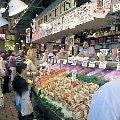Historic Fish Market Goes Green
Pike Place Market is a required stop for visitors to Seattle, Washington. For a century, vendors have sold everything from fruits to hats to books at colorful stalls.
Right at the entry to the market, dozens of tourists crowd around its most famous attraction: a fish stand where the workers throw a salmon back and forth several meters over shoppers' heads. The show always draws laughter and applause.
Taho Kakutani is a fishmonger here. He says as popular as this shop is, the owner and workers are concerned that some of the seafood they're selling today may not be around tomorrow. First-hand experience with over-fishing
Kakutani recounts a story fish market owner John Yokoyama told.
"When he was a child, him and his father could fish local ling cod and rockfish and salmon. And there really wasn't a question of availability. It was always just there. And things have changed over the last generation or two. Dramatically. So that he went out fishing last summer and he didn't catch a single fish." Over-fishing also has a cultural impact on groups like Native Americans, who have relied on local seafood for centuries.
"A lot of what we are known for, oysters and crab and salmon, are not simply food commodities," Kakutani says, "but they hold very important emotional and, in some cases, spiritual meanings for whole nations of people." Search for sustainability
A couple months ago, Yokoyama and his team began a project to switch to sustainably-harvested seafood. They researched what different marine science and environmental organizations consider sustainable. But Kakutani says it wasn't as simple as it sounds. "It seems like the differences in opinion vary as many as there are different organizations or groups. So what we're learning, so far, is that there isn't any set definition as to what sustainability means." Now Pike Place Fish Market is working with the Seattle Aquarium and a local sustainable sushi restaurant to determine what the shop should sell, and what it should get rid of.
So far, the shop has stopped buying farm-raised tilapia from Asia and wild-caught steelhead trout and monkfish. They're looking for sources of sustainable shrimp. Getting US consumers to try something new
Kakutani says shoppers get frustrated when they can't find their favorite fish, like Chilean seabass. "People love it and it's a fantastic fish. However, it's long been on an endangered species watch list and so we won't be carrying that anymore. And people are gonna have to learn about sablefish - which is a beautiful substitute for it, but yet it's not commonly known." According to Kakutani, the biggest challenge is finding new fish from sustainable sources to introduce to the public. For one thing, Americans usually don't cook their fish whole, as much of the world does. They tend to buy fillets or steaks. Kakutani says that means Americans haven't tried a lot of fish that taste best cooked whole, like branzino, sea bream, striped bass and mackerel. "Mackerel has been long thought of as, like, a bait fish for Americans. But, for most of the rest of the world, mackerel is like a delicacy. It's wonderful. And one of the things that we have going for us is that people are becoming a lot more food-savvy these days and are willing to be a little more adventurous." Kakutani believes everyone should know where their fish comes from.
He hopes the tourists from all over the world who crowd the Pike Place Market will take the shop's new sustainability message back to their hometowns.

